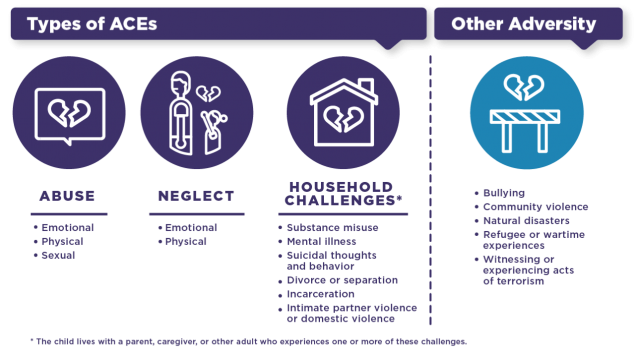
What are Adverse Childhood Experiences?

Adverse Childhood Experiences, or more commonly known as ACEs, are harmful experiences of abuse, neglect, household dysfunction, and other adversities that can lead to negative health outcomes in adulthood. The seminal 1998 study by Vincent J. Felitti, MD and colleagues published by the American Journal of Preventive Medicine found a strong connection between the number of ACEs experienced in a person’s life and the increased risks of health behaviors and diseases including alcoholism, depression, heart disease, and even death. According to data collected by the Centers for Disease Control and Prevention (CDC) between 2011 and 2020, over 60% of adults have had exposure to at least 1 ACEs, and 17% of adults were exposed to 4 or more ACEs in childhood.
Exposure and the effects of ACEs can create trauma for children and adults. From our research at the HOPE National Resource Center, we know that the practice of positive childhood experiences (PCEs) lessens the lifelong effects of harmful experiences and allows the brain to heal from trauma. The HOPE framework and the Four Building Blocks of HOPE guide those who work with children, families, and communities to promote equitable access to PCEs. By practicing and celebrating positive experiences, we can build trust, resilience, and heal from trauma.
The types of ACEs
The original study by Dr. Felitti and others determined 10 types of adverse childhood experiences that fall under three categories: abuse, neglect, and household challenges. Additional studies, like the Philadelphia ACE Survey, have since expanded the scoop of ACEs to include other adversities such as bullying and discrimination. The CDC outlines both conventional ACEs and other adversities:

Abuse
The child experiences these types of abuse:
- Emotional
- Physical
- Sexual
Neglect
The child experiences these types of neglect:
- Emotional
- Physical
Household Challenges
The child lives with a parent or an adult who experiences these types of household challenges:
- Substance misuse
- Mental illness
- Suicidal thoughts and behaviors
- Divorce or separation
- Incarceration
- Intimate partner violence or domestic violence
Other Adversities
- Bullying
- Community violence
- Natural disasters
- Refugee or wartime experiences
- Witnessing or experiencing acts of terrorism
Including the HOPE framework in ACEs screenings
ACEs screenings, or questionnaires that ask about past experiences of ACEs, can overwhelm children and families. A screening can trigger trauma and instill a demoralizing perception that the child and family are only defined by their adversities. People are more than their past exposures to ACEs and the resulting trauma. We need to view the complete picture of the lives of children, families, and communities that includes positive childhood experiences.
When completing an ACEs screening, include questions centered around PCEs using the Four Building Blocks of HOPE. Screening for both the positives and negatives helps build trust with the children and families that you serve. It shows them that you see them for all of their lived experiences, and that they are more than their ACEs score. Celebrate the strengths of the child and family and work with them to find access to the PCEs in their lives. By increasing access to PCEs for everyone, we can create a happier and healthier world.
Resources to promote positive childhood experiences
To help spread the practice of positive childhood experiences, the HOPE National Resources Center provides resources centered around the HOPE framework:
Contact us
Not sure how to start practicing positive childhood experiences in your work or community? Reach out to us with any questions.


